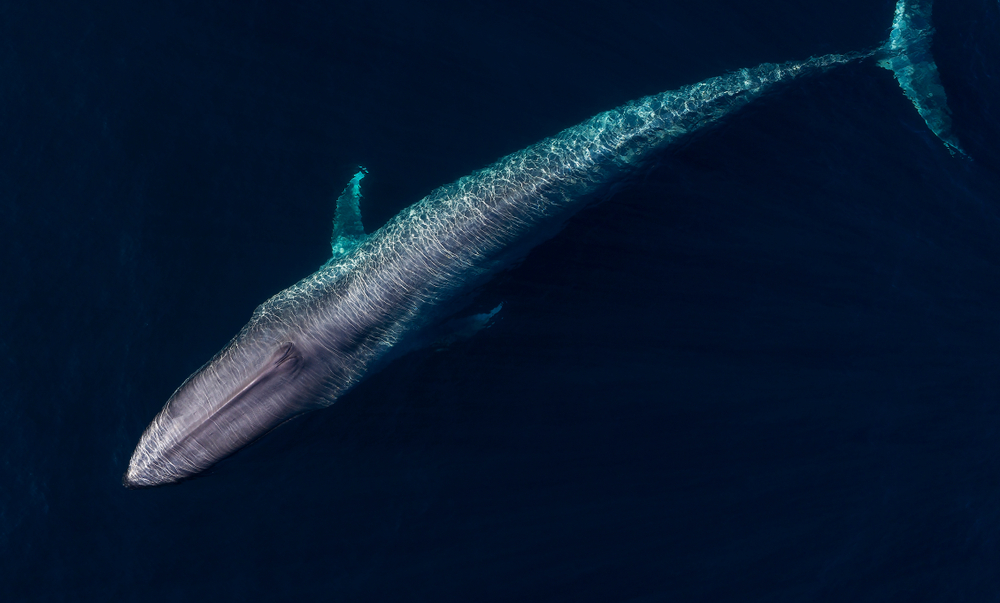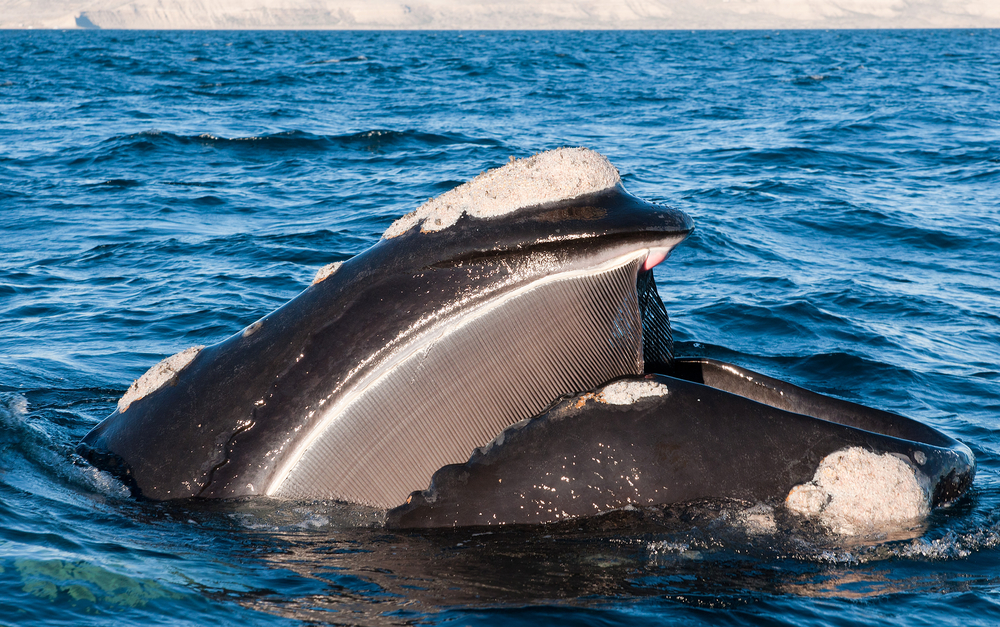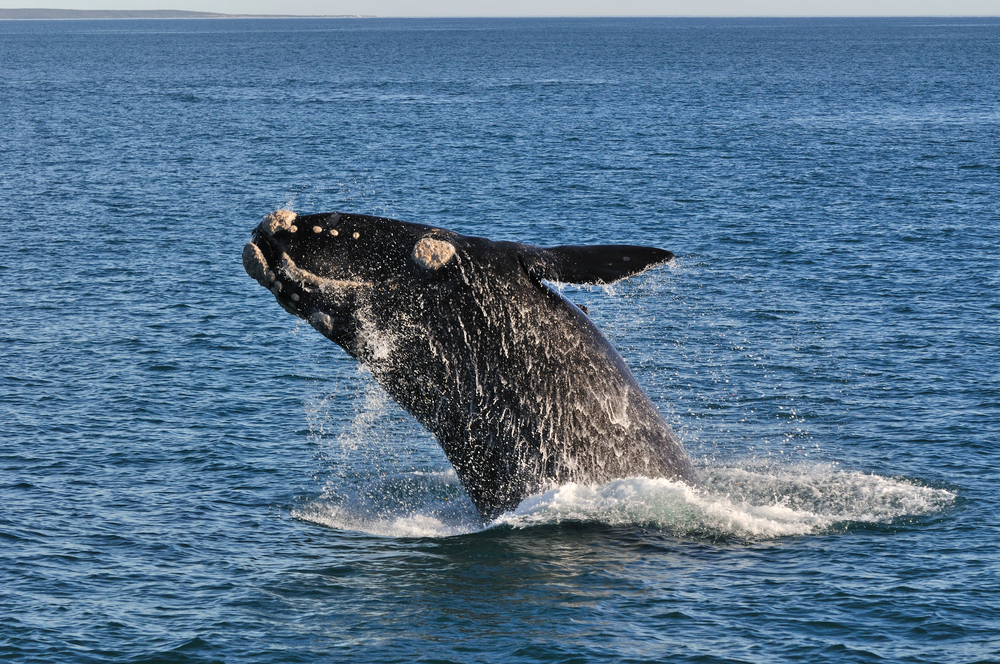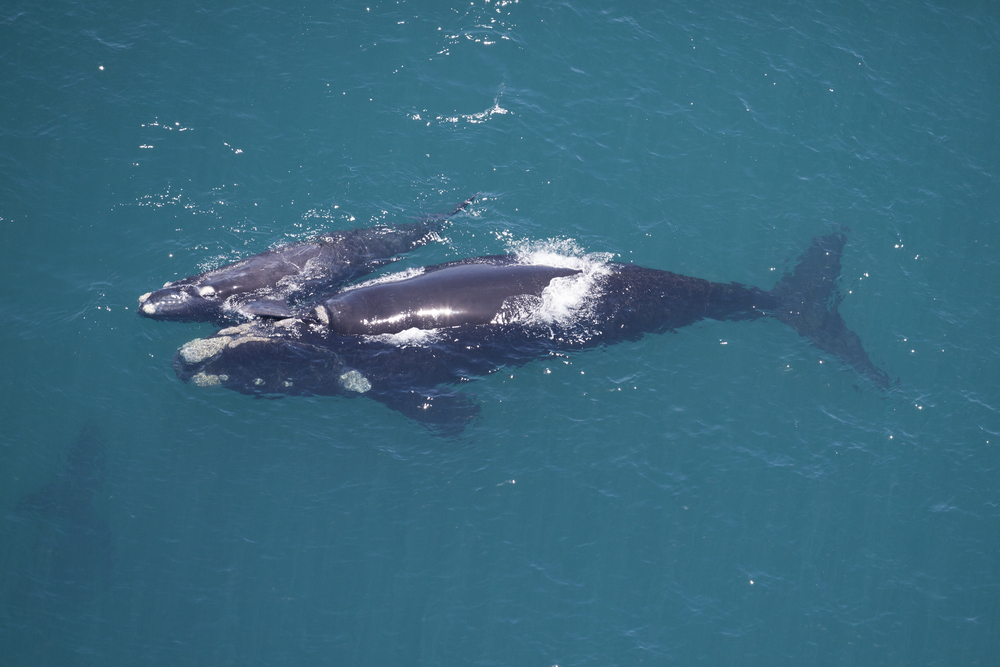The North Atlantic right whale (Eubalaena glacialis) is most similar to the southern right whale (Eubalaena australis). Both species belong to the same genus, Eubalaena, and share similar physical characteristics and behaviors.
About
The Southern Right Whale, scientifically known as Eubalaena australis, is a species of baleen whale belonging to the Animal Kingdom’s phylum Chordata and class Mammalia. It is part of the Balaenidae family, which includes other large whale species such as the North Atlantic Right Whale and the North Pacific Right Whale. Southern Right Whales inhabit the southern hemisphere’s temperate and subantarctic waters, including regions around Antarctica, South America, South Africa, Australia, and New Zealand.
These magnificent creatures are easily recognizable by their massive size, robust bodies, and lack of a dorsal fin. They have broad, paddle-shaped flippers and distinctive callosities, which are raised patches of rough skin on their heads. Southern Right Whales are known for their curious and friendly behavior, often approaching boats and engaging in surface-active behaviors such as breaching and lobtailing.
Southern Right Whales are filter feeders, using their baleen plates to strain small crustaceans, plankton, and other tiny organisms from the water. They undertake long migrations between their feeding and breeding grounds, with breeding grounds typically located in sheltered bays and coastal areas.
Conservation Concerns:
Southern Right Whales were heavily hunted during the whaling era, leading to a severe decline in their population. While commercial whaling of this species is now prohibited under international law, Southern Right Whales still face threats from entanglement in fishing gear, ship strikes, habitat degradation, and pollution.
The IUCN Red List classifies the Southern Right Whale as “Least Concern” due to its increasing population trend, particularly in some regions where conservation efforts have been successful. However, local populations may still face threats, and ongoing monitoring and conservation measures are necessary to ensure the continued recovery of this species.
Physical Characteristics
The Southern Right Whale (Eubalaena australis) is a large baleen whale known for its gentle nature and distinctive physical features. As one of the three right whale species, it inhabits the southern hemisphere’s colder waters, often seen near coastlines during breeding seasons. Here’s a detailed overview of the physical characteristics of the Southern Right Whale:
Size
- Body Length: Adult Southern Right Whales typically measure between 49 to 59 feet (15 to 18 meters) in length, with females generally being slightly larger than males.
- Weight: They are massive animals, with weights ranging from approximately 110,000 to 130,000 pounds (50 to 59 metric tons). Some large individuals can weigh as much as 176,000 pounds (80 metric tons).
Physical Characteristics
- Body Shape: The body of the Southern Right Whale is robust and stocky with a broad back and no dorsal fin, a characteristic feature of right whales. Their skin is often covered in callosities, which are roughened patches of skin that appear white due to whale lice and barnacles.
- Head: They have a large head that makes up about one-quarter of their total body length, with a strongly arched lower jaw. The upper jaw has a pronounced arch, giving them a wide mouth.
- Callosities: One of the most distinctive features of Southern Right Whales is the presence of callosities on their heads. These callosities form unique patterns, especially around the mouth, chin, and above the eyes, and are used by researchers to identify individuals.
- Baleen Plates: Like all baleen whales, Southern Right Whales feed by filtering small organisms (such as plankton and krill) through baleen plates. They possess around 200-270 baleen plates on each side of their upper jaw, which are long, fringed, and dark in color.
- Flippers and Tail: Their flippers are relatively short, broad, and paddle-shaped. The tail flukes are wide and deeply notched in the middle, with smooth, tapered edges, which they lift above the water’s surface when diving.
- Skin and Color: The skin is mostly dark gray or black, with occasional individuals showing patches of white on their belly. Newborn calves may have a lighter gray color that darkens with age.
- Blow: The blowholes are located on top of the head and produce a distinctive V-shaped blow, which is visible from a distance and can reach up to 16 feet (5 meters) in height.
Behavior and Adaptations
Southern Right Whales are known for their slow movements and propensity to stay close to coastlines during breeding and calving seasons. They are curious towards humans and often approach boats. Their feeding technique involves skimming the water’s surface or performing shallow dives to consume large amounts of plankton and krill.
The combination of their large size, distinctive callosities, and behavior makes the Southern Right Whale a fascinating subject for scientific study and whale-watching tourism, contributing to the growing awareness and conservation efforts for these magnificent marine mammals.
Reproduction
The reproductive cycle of the Southern Right Whale (Eubalaena australis) plays a crucial role in the survival and growth of this species:
- Mating and Courtship:
- Southern Right Whales typically engage in mating behaviors during the winter and spring months when they migrate to warmer, coastal waters for breeding. Mating involves complex interactions and can include multiple males competing for a female’s attention.
- Gestation:
- The gestation period for Southern Right Whales is approximately 12 months. This period allows the developing calf to grow to a significant size before birth, ensuring it is well-prepared for life in the ocean.
- Birth and Maternal Care:
- Southern Right Whales usually give birth to a single calf, with twin births being extremely rare. At birth, calves are about 16 to 20 feet (5 to 6 meters) in length and weigh approximately 3,000 pounds (about 1,360 kilograms).
- Newborn calves are nurtured and protected by their mothers, nursing on rich, fatty milk for the first few months of life. This close maternal bond is vital for the calf’s development, with nursing continuing for at least 6 to 12 months.
- Infant Development:
- During this time, calves learn essential skills for survival, including how to communicate, navigate, and eventually, feed on their own. The mother’s guidance is crucial for the calf’s successful integration into whale society.
- Sexual Maturity:
- Female Southern Right Whales reach sexual maturity at about 10 years of age, while males mature slightly later. However, females may not give birth until they are older, with a typical calving interval of 3 to 5 years, allowing them to invest considerable care in each offspring.
The reproductive cycle of the Southern Right Whale, characterized by lengthy gestation, intensive maternal care, and slow maturation, underscores the significant investment these whales make in each calf. This strategy is essential for the growth of healthy individuals capable of contributing to the population’s recovery and longevity.
Lifespan
Southern Right Whales (Eubalaena australis) exhibit notable longevity, particularly in their natural marine environments:
- Lifespan in the Wild:
- Southern Right Whales can live for over 70 years, with some individuals possibly reaching up to 100 years. This extensive lifespan is indicative of their slow growth and late maturity, traits common among large whale species.
- Lifespan in Captivity:
- Southern Right Whales are not typically held in captivity due to their size, complex needs, and the ethical considerations of keeping such large, migratory animals in confined spaces. Therefore, data on their lifespan in captivity is not applicable.
- Biggest Threats:
- Ship Strikes: As these whales often inhabit coastal waters, they are at risk of collisions with large vessels, which can result in serious injuries or death.
- Entanglement in Fishing Gear: Fishing nets and other marine debris pose significant risks, leading to entanglement that can cause physical harm, starvation, or drowning.
- Climate Change: Changes in sea temperatures and ice patterns can affect the distribution of krill and other food sources, impacting the whales’ feeding habits and migration patterns.
- Pollution: Chemical pollutants, such as heavy metals and organochlorines, accumulate in whale tissues, potentially affecting their health and reproductive capabilities.
- Historical Whaling: While not a current threat due to international protection, past whaling significantly reduced their populations. The species is still recovering from these historical impacts.
Conservation efforts and international protection have been crucial in aiding the recovery of Southern Right Whale populations from the brink of extinction. Ongoing research and monitoring are essential to understanding their needs and mitigating the threats they face, ensuring the long-term survival of this majestic species.
Eating Habits
Southern Right Whales (Eubalaena australis) have a specialized feeding strategy that reflects their adaptation to the nutrient-rich waters of the Southern Hemisphere:
- Diet:
- Their diet primarily consists of small zooplankton, including copepods and krill. These tiny, shrimp-like organisms form the basis of the Southern Right Whale’s nutrition, providing the necessary energy for their large size and extensive migrations.
- Feeding Techniques:
- Southern Right Whales employ a method known as “surface skimming” to gather their food. They swim slowly through the water with their mouths open, filtering zooplankton through their baleen plates, which act like a sieve to trap food while expelling water.
- Another technique they use is “upward vertical feeding,” where they swim upward towards the surface with their mouth open, capturing dense concentrations of zooplankton. This method is particularly effective in areas where their prey aggregates in large swarms.
- Adaptations for Feeding:
- Their large heads and long, arched upper jaws are lined with baleen plates, which are crucial for their filter-feeding mechanism. The baleen plates are fringed with fine hairs that trap food particles as water is expelled through them.
- The callosities, or rough patches of skin on their heads, are not directly related to feeding but are unique identifiers. However, their large size and slow swimming speed are adaptations that facilitate their continuous feeding strategy.
The feeding habits of Southern Right Whales are closely tied to their migratory patterns, with feeding occurring primarily in the colder, food-rich waters of the Antarctic before migrating to warmer waters for breeding and calving. This annual cycle ensures that they can capitalize on the abundant food sources in the Southern Ocean, supporting their energy needs for breeding and maintenance.
Uniqueness
The Southern Right Whale (Eubalaena australis) stands out for several unique features and behaviors that distinguish it from other marine mammals:
- Distinctive Callosities: One of the most notable features of Southern Right Whales is the pattern of callosities on their heads. These rough patches of skin are unique to each individual, much like fingerprints in humans, and are used by researchers for identification. The callosities are inhabited by small crustaceans called whale lice, which contribute to their white or yellow appearance.
- Lack of a Dorsal Fin: Unlike many other whale species, Southern Right Whales lack a dorsal fin. This feature, combined with their broad, rounded backs, makes them easily recognizable.
- Surface Skimming Feeding Behavior: Southern Right Whales have a unique feeding method where they swim slowly with their mouths open, skimming the water for plankton. This surface feeding behavior is a sight to behold and is characteristic of their feeding habits in the nutrient-rich waters of the Southern Hemisphere.
- V-Shaped Blow: When exhaling, the blow of a Southern Right Whale is distinctly V-shaped, making it possible to identify the species from a distance. This unique blow pattern is due to the whale’s double blowhole structure.
- Strong Maternal Bonds: Southern Right Whales exhibit strong maternal bonds, with calves staying close to their mothers for extended periods. Mothers are often seen with their calves in the sheltered breeding grounds, providing protection and guidance.
- Long Migrations: They undertake long annual migrations from their feeding grounds in the cold waters around Antarctica to warmer breeding and calving areas along the coasts of the southern continents. This migratory behavior is critical for their survival and reproduction.
- Recovery from Whaling: Once hunted nearly to extinction for their oil and baleen, Southern Right Whales have made a significant comeback due to international protection efforts. Their recovery is a testament to the resilience of the species and the success of conservation measures.
These unique characteristics, along with their curious and often friendly behavior towards humans, make the Southern Right Whale a fascinating subject of study and conservation, highlighting the importance of protecting these gentle giants and their habitats.
FAQ’s
1. Which species is most like the southern right whale?
2. How fast does the southern right whale swim?
Southern right whales typically swim at speeds ranging from 3 to 5 miles per hour (5 to 8 kilometers per hour). However, they are capable of short bursts of speed when necessary, reaching up to 10 miles per hour (16 kilometers per hour).
3. How deep and long does the right whale swim?
Southern right whales are known to dive to depths of around 300 meters (984 feet) when foraging for food, although they can potentially dive deeper.
In terms of distance, they can cover hundreds of kilometers during their migrations, but the exact distance and duration of their swims vary depending on factors such as food availability, mating behavior, and environmental conditions.
Related Family Species
Sources
- Britannica, Southern Right Whale, https://www.britannica.com/animal/southern-right-whale, retrieved February 2024.
- Burnie, David & Wilson, Don, Animal, Smithsonian Institute, Washington DC.
- Clutton-Brock, Juliet and Wilson, Don, Mammals, Smithsonian Handbooks, New York, NY.
- Hickman et al, Integrated Principle of Zoology, McGraw Hill, Boston.


















































































